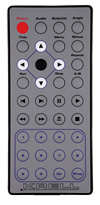Krell DVD Standard DVD player Page 3
 Were these objections removed, theoretically at least, I'd still be left facing a decision about which I preferred: the 600-line progressive image created by the Dwin TranScanner from the Krell's interlaced 480i output, or the direct-to-projector 480p image from the Krell's progressive output. While HT fans normally don't sit and watch test patterns, these tests can enlighten us as to what's going on behind the scenes. Everything I saw convinced me that the Krell's progressive circuitry was rock-steady, and as sharp and detailed as any I've seen. Film grain, for instance, deliciously prevalent in The Stunt Man (Anchor Bay DV11716), was clearly visible over the progressive outputs, while the processed 600p image derived from the TranScanner was more homogenized. The real irony here was that, the better your projector and setup, the more visible the scan lines will be. My projector will even show me scan lines with a 1080i hi-def image (but not with 720p, which exceeds the resolution capabilities of my 7-inch CRTs), but even so, the Krell put me as close to a hi-def picture from a standard DVD as I've ever been!
Were these objections removed, theoretically at least, I'd still be left facing a decision about which I preferred: the 600-line progressive image created by the Dwin TranScanner from the Krell's interlaced 480i output, or the direct-to-projector 480p image from the Krell's progressive output. While HT fans normally don't sit and watch test patterns, these tests can enlighten us as to what's going on behind the scenes. Everything I saw convinced me that the Krell's progressive circuitry was rock-steady, and as sharp and detailed as any I've seen. Film grain, for instance, deliciously prevalent in The Stunt Man (Anchor Bay DV11716), was clearly visible over the progressive outputs, while the processed 600p image derived from the TranScanner was more homogenized. The real irony here was that, the better your projector and setup, the more visible the scan lines will be. My projector will even show me scan lines with a 1080i hi-def image (but not with 720p, which exceeds the resolution capabilities of my 7-inch CRTs), but even so, the Krell put me as close to a hi-def picture from a standard DVD as I've ever been!
Deaf Men Get Religion
I was comparing some scenes from The Fifth Element (Columbia TriStar 82409) on both the Pioneer DV626D and the Krell DVD Standard, and what struck me as the greatest difference was the sound. True, both were feeding the same Krell HTS pre-pro, but the Standard presented a much more dynamic presentation off the same Dolby Digital 5.1 track. I hadn't touched the levels, but I had to turn up the Pioneer to get the same vibe.
When it came to 2-channel audio, the Krell worked fine from its digital output as a CD transport, but I quickly developed a liking for it as a full-fledged CD player, used from its 2-channel analog outputs. The 24/192 Burr-Brown DACs were easily more effortless, open, and resolute than the 20-bit Crystals in the Krell HTS2. (The upgraded Krell HTS 7.1—review in progress—and new Showcase processor use the Burr-Browns as well.) No one is going to complain about the sound either way, but the Krell DVD Standard was an excellent DVD player on its own.
The DVD Standard's front panel suffers from a logo shortage. Nowhere to be found are the letters SACD or DVD-Audio. Look as you might, hither and yon, there's not a 5.1 multichannel analog output to be found. The DVD Standard is, above all, a DVD player, and if you're considering laying down $8000 to pick one up, reconcile yourself to that fact. You can get an SACD player these days for a few hundred bucks elsewhere, and I recommend you don't spend much more than that for an SACD or DVD-A player just yet. While it would have been nice to get it all in one box, certain events—out of the control of such high-end luminaries as Krell, Theta, and Ayre, and in control of piracy-paranoid music companies—have conspired to make certain that that isn't going to happen anytime soon. Until the industry gets its ducks in order and lets manufacturers pass a multichannel digital output from player to processor, what good is a 6-channel analog output with only the K-Mart bass-management capabilities of most of the current crop of SACD and DVD-A players? Eventually, it will occur to the recording industry that they can't sell multichannel digital music if they won't let manufacturers process the signal in the digital domain.
Report Card
My daughter Laura is taking a summer course in Micro-Economics. One of her professor's study questions dealt with the price elasticity of DVD players, and although it humorously referred to "improvements in vision technology" in forecasting hi-def blue-laser DVDs, his point was clear: There's something else coming down the road. There always is.
So do you drop $8000 on a state-of-the-art DVD player just as they're about to blow the roof off the technology with a new Blue Light (literally) special? Why not? If you have hundreds or thousands of standard-definition DVDs, why wouldn't you want to see and hear them forever in the best light possible? New technology and some future medium may be better, but there aren't that many "White Albums" out there that you'll feel compelled to repurchase. Not when the player in question, the Krell DVD Standard, is so darn good. When I play this "White Album" backwards, all I keep hearing is, "Paul isn't dead, he's touring; tickets are expensive, but then, the best usually are!" Bottom line: If you're using a high-quality projection and sound system, the Standard will give you a home-theater experience that is enjoyable and highly addictive.













































